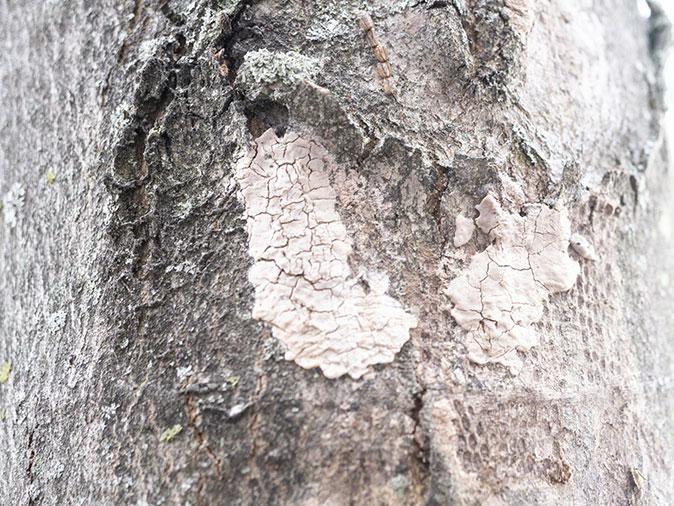Holmdel, Morganville, and communities in Monmouth County as well as elsewhere in New Jersey are facing an escalating challenge this summer as spotted lanternflies (SLF) continue to spread. This invasive species, native to China and first detected in Pennsylvania in 2014, has become a significant threat to trees and agriculture. In this blog post, we’ll take a closer look at this growing pest problem and provide residents with effective measures to safeguard their trees and stop these destructive pests.

Spotted lanternfly identification
In order to help residents easily identify all stages of spotted lanternfly development, we’ve put together brief descriptions of adult spotted lanternflies, nymphs, and egg masses.
Adult spotted lanternflies
Adult lanternflies are about one inch long and have a wingspan of approximately two inches. When at rest, their forewings are grayish with black spots and a light brownish-gray background. The hind wings, which are revealed during flight, are vibrant red with black spots. The upper abdomen is yellow with black bands, while the lower abdomen is black with broad yellow bands.
Nymphs
The nymphs of the spotted lanternfly complete four growth stages. In their early stages, they appear black with white spots but as they mature, they develop red patches and become larger. The final nymph stage resembles the adults that do not have fully developed wings.
Egg masses
Spotted lanternflies lay their eggs in masses, usually in late fall or winter. The egg masses are about an inch long, and grayish-brown in color, and look similar to spots of mud. Egg masses may be found on trees, rocks, park benches, vehicles that have been stationary for a while, and sides of buildings as well as other smooth surfaces.
Are spotted lanternflies moths or flies?
Actually they’re neither. Spotted lanternflies belong to a group of insects known as planthoppers. They are members of the Order Hemiptera, which includes cicadas.
Why NJ counties are seeing a surge in spotted lanternflies this summer
Human activity is increasing their range
Since their initial introduction in Pennsylvania, the spotted lanternfly population has been steadily expanding, reaching neighboring states including the Garden State. Because they often hitch rides on vehicles, campers, firewood, outdoor furniture, and other objects, their range of dispersal has greatly increased.
They don’t have natural predators
As we’ve already mentioned, spotted lanternflies are an invasive species. That means the natural predators and disease that would help control their populations in their native habitat are not present in New Jersey or other affected areas.
Lack of awareness and early detection
The surge in spotted lanternflies could also be attributed to a lack of early detection and awareness among New Jersey residents. Although they have a very distinct appearance, people may not be familiar with them, what their egg masses on trees look like, or of the impact they can have on trees in our region. As a result, they may go unnoticed, which allows their population to grow unchecked.
What impact do spotted lanternflies have on trees?
Both adult and nymph spotted lanternflies damage trees when they feed on sap by puncturing the bark. This act weakens trees and leaves behind a trail of honeydew—a sticky substance that promotes the growth of mold and attracts other pests. Going untreated, infestations can cause tree decline and death as well as reduce crop yields. Not only are maples, walnuts, willows, and some fruit trees affected by spotted lanternfly activity, but 70 different plant species in total.
Preventing Spotted Lanternflies In New Jersey
Currently all 21 counties in New Jersey are included in the spotted lanternfly quarantine zone, which means all residents should familiarize themselves with what spotted lanternflies look liked (in all life stages) and use the SLF checklist the state has provided to help residents stop the spread of these pests.
You’ll want to inspect any outdoor items for spotted lanternfly egg masses as well as adults and nymphs and avoid moving them if you discover activity. In addition to the items noted above, other items on the checklist include:
- Basketball backboards
- Boats & boat trailers
- Cardboard boxes
- Storm doors
- Grills
- Dog houses
- Yard decorations
- Bikes
- Signs
- Playhouses
If you discover egg masses or nymphs, you’ll want to scrape them off and destroy them right away. You should also consider contacting a pest control company for help eliminating spotted lanternflies that have taken up residence on your property.
Arrow now offers a spotted lanternfly knockdown program
Here at Arrow Pest Control, we are pleased to introduce our new spotted lanternfly knockdown program for property owners in Hazlet, Manalapan, Tinton Falls, and Freehold as well as throughout our multi-county service area. This service includes:
- An initial inspection and assessment of the affected property
- Installation of spotted lanternfly traps on trunks of trees to catch adults and nymphs
- An exterior spraying of the house or building to exterminate spotted lanternflies where they “sun” themselves
- Destruction of any egg masses found
Designed to reduce spotted lanternfly activity by up to 80%, this six-treatment program runs May through October. At the end of each season, we’ll remove the traps and store them until the following year!
Don’t wait for spotted lanternflies to take over, let’s work together to stomp these pests out
The increasing spotted lanternfly problem in Monmouth County, New Jersey, demands immediate attention from residents. For help protecting your trees and plants from spotted lanternflies this summer, simply fill out the form below or give us a shout to schedule service!














